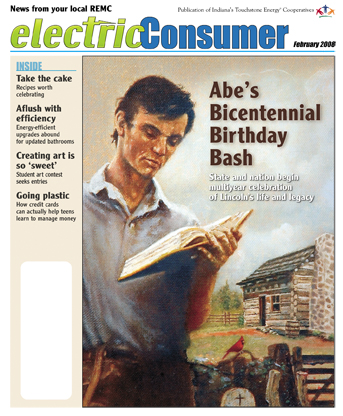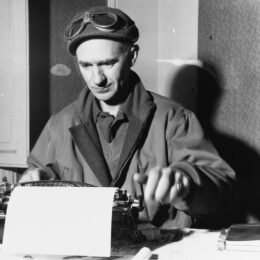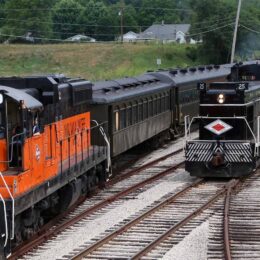
At his rural Spencer County studio, artist Tom Kennedy kneels beside his montage of images tracing the life of Abraham Lincoln. The 57-year-old oil painter and free-lance commercial artist spent two years researching and painting the 42-by-58-inch canvas. To see the entire painting and find out how to get high-quality reproductions, check out Kennedy’s web site:www.thomaskennedyart.com. Kennedy also painted a Christmas ornament for the Lincoln Boyhood National Memorial which was displayed on the 2007 White House Christmas tree.
Before Abraham Lincoln belonged to the ages, he belonged to the Ohio, Anderson and Sangamon rivers. Before he belonged to the Union he saved, he belonged to the fields and flatboats, borrowed books and backwoods, creeks and courtrooms of Kentucky, Indiana and Illinois.
As the nation celebrates Lincoln’s 200th birthday over the next two years, Hoosiers and our neighbors to the south and west will be making sure the nation realizes Lincoln’s roots began and belong here — where he was born, grew up and lived.
Lincoln was born Feb. 12, 1809 in a log cabin in Kentucky. He rose to national prominence as a prairie lawyer and politician in Illinois. And he did more than pass through Indiana.
In December of 1816, within days of Indiana’s statehood, Lincoln’s family moved from Kentucky, crossed the Ohio River near Troy and settled in what became northern Spencer County. His father was looking for a new start in a new state free of title disputes over land and free of the sin of slavery.
Here, in Indiana, Lincoln rose to his physical and intellectual prominence, growing from a 7-year-old boy to a 21-year-old man. Here — on the harsh Hoosier frontier — Lincoln worked, studied and lived a quarter of his life. Those were his formative years when he developed his sense of honesty, integrity, self reliance and judgment. They were hard years that also hewed both the melancholy side of his nature and his compassion.
“Everybody knows Abraham Lincoln,” said Connie Nass, executive director of Indiana’s Abraham Lincoln Bicentennial Commission, “but you’d be surprised at the number of Hoosiers who don’t realize the time he spent here was the basis for his life.”
Over the next couple years, the bicentennial seeks to celebrate, re-examine and expound on Lincoln’s vast accomplishments as president, and his ideals and spirit.
“He gave new meaning to what we stand for,” Nass said. “He gave new meaning to the word ‘united’ when we call ourselves the United States of America.”
Nationally, the bicentennial kicks off this month in Hodgenville, Ky., where Lincoln was born 199 years ago. The national focus shifts to Indiana for a Mother’s Day tribute in May. The death of his mother, Nancy Hanks Lincoln, less than two years after moving to Indiana devastated the 9-year-old Lincoln. The land that holds her grave, where the Lincolns lived, is now the Lincoln Boyhood National Memorial, a part of the National Park Service.
To help raise awareness of Lincoln’s life in Indiana, last summer the state Lincoln commission had special panels attached to Indiana’s highway welcome signs noting “Lincoln’s Boyhood Home.” The commission received almost $1.5 million in state funding last year to promote the bicentennial.
 In addition, a bill cruising its way through the Statehouse at Electric Consumer’s deadline in January would create a special Lincoln license plate. The plate would be an option to Hoosier motorists at no extra charge for 2009 and may even be available at the Bureau of Motor Vehicles later this year.
In addition, a bill cruising its way through the Statehouse at Electric Consumer’s deadline in January would create a special Lincoln license plate. The plate would be an option to Hoosier motorists at no extra charge for 2009 and may even be available at the Bureau of Motor Vehicles later this year.
The plate proposal was introduced by Rep. Russ Stilwell (D-Boonville). “Lincoln’s childhood years in Indiana helped him develop the strength, compassion and moral integrity needed to lead the U.S. through one of its darkest eras,” Stilwell said. “This plate will unify Hoosiers in commemorating Indiana’s role in the life of one of history’s most notable figures.”
Other plans include creating Lincoln artwork and enhancing Lincoln’s legacy in public schools.
In partnership with the state’s Lincoln commission and the Historical Bureau, the state Arts Commission has issued a call to Hoosier artists to develop an art project reflecting Lincoln’s life in Indiana for Lincoln State Park in Spencer County.
Nass noted that multifaceted Lincoln studies also have been planned for all grades for Indiana schools.
In addition, Suellen Reed, state superintendent of public instruction, is promoting a campaign to have a Lincoln lithograph placed in every classroom. In December, she unveiled the montage of scenes visually tracing Lincoln’s life which was painted by Spencer County artist Tom Kennedy. He spent more than two years researching and painting the work.
Kennedy also gave a print to first lady Laura Bush when he and Reed visited the White House in November to view an 18-foot Christmas tree decorated with ornaments representing the national parks. Kennedy created the ornament for the Lincoln Boyhood National Memorial.
Other events nationally will be a rededication of the Lincoln Memorial in Washington, D.C., and a redesigned 2009 penny series and five dollar bill.
Additional events include educational programs, arts presentations, documentaries, conferences and museum exhibits around the nation.
As an adult, Lincoln talked little of his hard years in Indiana. In those years, he lost both his mother and sister. But Kennedy notes those times surely were never far from his mind.
“You just don’t talk about the things that mean the most to you, but you think about them all the time,” he reasoned. “There wasn’t a day in his life he didn’t think about his mom and his sister. He thought about Spencer County because they were the things that meant the most to him. He had a lot of thoughts of Indiana.”
Over the next two years-plus, as all the candles are lit for Lincoln’s big bicentennial celebrations, Hoosiers and the nation will have a lot of thoughts on Lincoln’s life and his legacy — and the role Indiana played in both.



